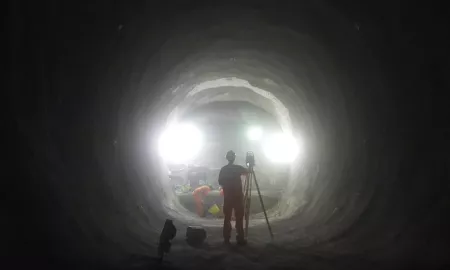On Thursday 5 December, Sheridan Elliott – SOCOTEC Monitoring’s technical manager – presented the innovative solution devised to monitor the Barking Riverside Extension project to a panel of judges at the NCE Tunnelling Awards.

As a finalist in the Instrumentation & Monitoring category, Sheridan demonstrated how SOCOTEC Monitoring’s innovative use of existing instrumentation and monitoring techniques is contributing to an improved outcome for Transport for London on the Barking Riverside Extension project.
Talking about the shortlisted monitoring solution, Sheridan commented: “Under normal circumstances, the monitoring of this kind of asset would require the use of an optical based system. For this project, however, there were several reasons why this solution would not be suitable. Thanks to the technical expertise and extensive field experience of the engineers at SOCOTEC Monitoring, an alternative solution was devised and implemented. It’s great to see this solution, and the team behind it, being recognised as finalists at the prestigious NCE Tunnelling Awards. We work hard to ensure that the solutions SOCOTEC Monitoring offers clients are fit-for-purpose, whether that means turning to the latest technologies or using existing instrumentation and techniques in new and innovative ways.”
The Shortlisted Monitoring System
Rather than using an optical system for the Barking Riverside Extension project, cable free tilt sensors were used to determine tunnel ovalisation along with cant and twist measurements of the track.
Optical systems rely on the line of sight between each RTS and the prisms it reads. With elevated levels of dust build-up in the HS1 running tunnels, and with passing trains running at high speed (140mph), prism cleaning would need to be undertaken regularly to keep sight lines clear. This would have required further scheduled isolated possessions which are costly and disruptive, and therefore not an option in this case. Additionally, RTS units have the potential to be affected by the speed of the trains and the piston effect of the air they displace, with vibrations impacting the level compensators of the instruments and air turbulence having the ability to cause reading inconsistency.
Tilt sensors do not require cleaning, eliminating the need for extensive maintenance and limiting the amount of work and isolation periods required.
As an RTS is connected to a network of prisms, if the instrument fails it means that a large percentage of the system is down in one confined area and that survey control passed between the RTS units is lost. If a tiltmeter fails it is limited to a single point resulting in a much lower impact on the overall system. There were 258 tilt sensors in total which are sectioned off into eight separate communications gateways. Even if an entire gateway fails, it would only take down 1/8 of the system, minimising impact further.
Another reason for not using an RTS system in this instance is that they are power intensive, which makes batteries an inadequate solution meaning that cabling would have been required. Any cabling works would have resulted in a lengthier installation process which could not be afforded due to the time constraints and pre-booked possessions. Control panels which need to be placed within 25m of the actual RTS itself would also have needed to be installed inside the tunnel in a location only accessible during isolated possessions. The required placement would also have meant the blocking of one of the two emergency walkways, which would not have been approved.
In comparison, the tiltmeter sensors have a battery life of two to three years if set to an hourly monitoring frequency and, with careful management, the battery life could be extended further. Since the tiltmeter system is both wireless and battery powered, the cabling issue was resolved. The gateway units used to gather data from the tiltmeters required connection to mains power but, as these were situated in the access shaft, with round the clock accessibility, there is no issue with that. Tiltmeters use long-range LoRa technology requiring no cables and connect via a 4G router located at ground level in the head house, removing the need for cabling inside the tunnel.
Using wireless tilt sensors also meant that there was no need for any enclosures in the tunnel, thus not blocking any emergency escape routes. The tilt sensors themselves are of a sufficiently low profile as not to interfere on either walkway.
The final advantage of the cable free tiltmeters is that there is no requirement to electrically bond any of the equipment to ground, as there would have been with the RTS equipment. This avoids expensive design and consultation work, additional isolated possessions and expensive qualified electrical sub-contractor attendance.
A full case study about the monitoring and surveying works used in the Barking Riverside Extension project can be read here.
SOCOTEC Monitoring has extensive experience designing and implementing monitoring and surveying solutions for existing tunnels, escalator barrels, ticket halls and circulation areas, measuring movement as a result of tunnelling activity. If you have a tunnelling project you would like to discuss, please contact the SOCOTEC Monitoring team. We’re always happy to share our expertise.
Want to find out more about SOCOTEC's geotechnical and structural monitoring services?

You might also like







Add new comment